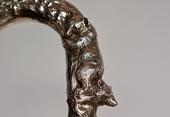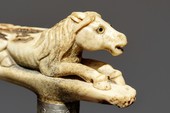The Collie herder dog, well known as the Scottish Herder was descended from a localised variety of herding dogs from Scotland and Wales. The Rough Collie had been used for centuries as a sheepdog in the Scottish Highlands.
Today Rough Collies are more show dogs than working dogs. The breed has been developed to be an excellent companion animal and fits perfectly in most homes. * Herding with Rough Collies.
This original cane is fashioned of a single piece of stepped rattan, the figure depicts a masterly carved Collie Herder head with inset glass eyes, it shows the characterizing protruding muzzle and the long hair around the neck. It is brand marked BRIGG LONDON close to the crutch. In this carving, we got a good portrait of one of the most brave dog races.
This Scottish dog is 4 cm high x 12 cm to the side x 4 cm wide and the O.L. is 90 cm, it ends with a bimetal ferrule, it has minimal signs of usage, and the condition is excellent.
Swaine Adeney Brigg, one of Britain’s oldest and most prestigious manufacturers of leather goods, walking canes and umbrellas. A recent book “IN GOOD HANDS” about his craftsmanship has been published very recently: http://www.swaineadeney.co.uk/about/the-book/index.html
* In nearly every world mythology, our constant companion the dog has come to be associated with our constant companion, death. Wild carrion devourers sniffing and consuming the death, tame, ever-hungry, digging into the depths of the earth with their paws, burying or finding bones, dogs attend death and assimilate death. * The book of Symbols.
Antique Walking Cane Collection Antiker Spazierstock Sammlung Antique Canne Collection Antiek Wandelstok Verzameling Antico Bastone Collezione Античный трость коллекции Baston Antiguo Coleccion















